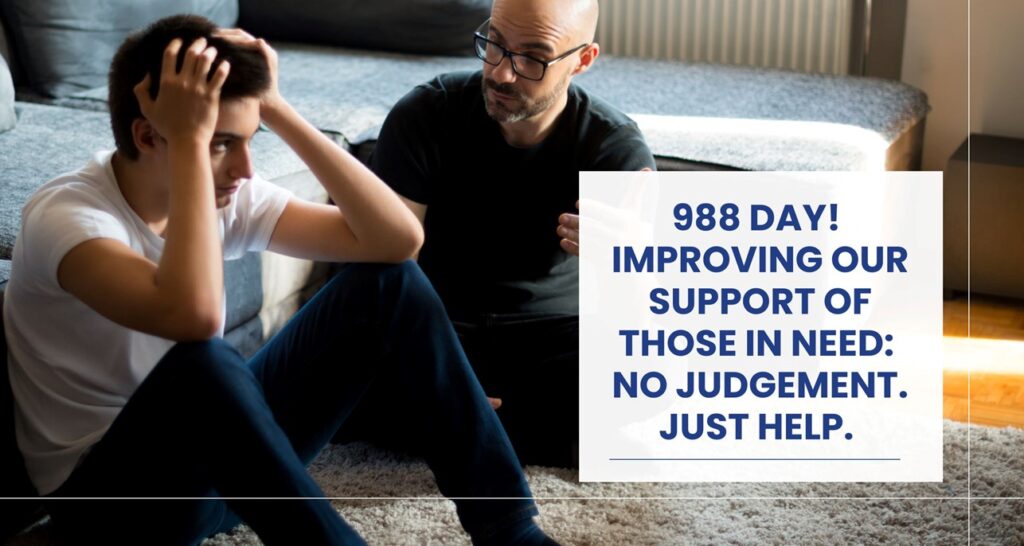In a world where mental health struggles are all too common – and our youth are still challenged to find appropriate services during the current Children’s Mental Health Crisis – it’s crucial to recognize and support the resources that provide help. The CDC spotlights suicide as a leading cause of death, affecting people of all ages: among the top 9 for people ages 10 – 64 and the second leading cause of death for people ages 10-14 and 25-34. Some of these figures may even be underscored when vehicular accidents, gun-related suicide, and intentional opioid overdose are methods of self-harm. In the CDC’s recently released Youth Risk Behavior Survey for 2023, the stats command everyone to become more aware of suicide thoughts/ideation and take a more supportive role in our communities: 1 in 5 teens still seriously thought about suicide, 1 in 6 made a plan, and 1 in 10 attempted to kill themselves.
An essential resource for communities is the 988 Suicide & Crisis Lifeline. This service averages over 400,000 calls per month. Since its launch two years ago in July 2022, the 988 Lifeline has received more than 5.5 million calls, texts, and chats. The lifeline offers immediate assistance to those experiencing depression, suicidal ideation, or other mental health crises, demonstrating its essential role in saving lives and providing support.
A Day to Educate and Advocate
September 8th – 988 Day – serves as a national call to action to raise awareness about this vital service. It’s a reminder that mental health is just as important as physical health, and that seeking help is a sign of strength not weakness.
The 988 Lifeline – call or text 988 – is a beacon of hope for many, offering a direct connection to trained counselors 24 hours a day who can provide immediate support and connect individuals to local resources for ongoing help.
One of the biggest barriers to seeking help for mental health issues is the stigma associated with it. People often fear judgment or believe that they should be able to handle their problems on their own. Families impacted by addiction often deny any mental health concerns, and shame family members vulnerable to depression/anxiety/ADHD/etc. Those courageous enough to discuss this with family or friends who don’t understand these issues and the help that is available may be ridiculed and teased. This stigma can discourage individuals from reaching out and getting the support they need, leading to feelings of isolation and hopelessness.
Changing Language – Changing Attitudes
To combat this, we need to improve the way we talk about mental health. Language plays a powerful role in shaping our perceptions and attitudes. Using person-first language, which emphasizes the individual rather than their condition, helps to reduce stigma and promote empathy. For example, saying “person experiencing depression” rather than “depressed person” puts the focus on the individual’s experience rather than labeling them by their condition.
It is important to understand that suicidal ideation may fester in individuals struggling with an undiagnosed mental health or substance use disorder. It also can indicate the impact of long-term trauma, making children living with families impacted by the disease of addiction extremely vulnerable. Chronic pain and stressful life events can also lead to suicidal thoughts.
Education is key to changing how we view mental health. By educating ourselves and others about the signs of mental health struggles and the resources available, we can create a more supportive environment for those in need. This includes recognizing the warning signs of suicide and knowing how to respond. Simple acts of kindness, like listening without judgment or encouraging someone to seek professional help, can make a significant difference.
Families and communities play a crucial role in supporting individuals with mental health issues. Open and honest conversations about mental health can help normalize these discussions and make it easier for individuals to seek help. Providing resources, such as information about the 988 Lifeline, and creating supportive environments where people feel safe to share their struggles can help prevent crises before they occur.
The Lifesaving Impact of 988
The 988 Lifeline is a critical resource that can provide immediate help to those in crisis. By calling 988, individuals can speak with trained counselors who offer support, crisis intervention, and information about local resources. This service is a lifeline for many, providing a glimmer of hope in their darkest moments.
Promoting the 988 Lifeline and educating others about its importance can help ensure that more people are aware of this valuable resource. When we replace judgement with an earnest desire to help those in our lives and in our communities who are hurting, our help truly can make a difference. It’s vital that we continue to support and advocate for services like 988, which provide crucial assistance to those in need.
